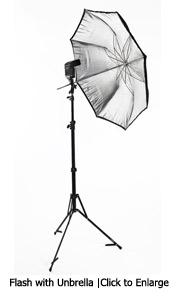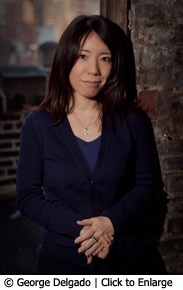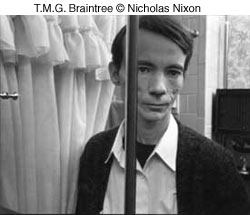NYIP's newest student advisor, George Delgado, is a professional photographer, and an NYIP Digital Photography School. In addition to running a portrait and wedding photography business here in New York City, George has a wide variety of experience in business and an extensive background in the aviation industry including stints as a pilot and aviation instructor. In this article for NYIP. com, George discusses the use of small flashes over studio strobes.
NYIP students and aspiring photographers often wonder; should they invest in studio strobes or is there another alternative? Powerful hot shoe flashes and new DSLR cameras able to produce better images at higher ISO settings have opened up new possibilities — "studio" results from small hot shoe flashes.
30 years ago, most commercial still photography was done with film rated at ISO 64. You needed a huge amount of light to get a good exposure at f8 and that's what studio strobes provide — a huge amount of light. Today, high end DSLRs can produce clean, low-noise images at ISO 800. That means they need about 1/8th of the light to shoot at the same aperture, opening up the possibility of smaller, lower powered flashes doing just as well now as studio strobes did a few years back.
Studio strobes and hot shoe flashes use exactly the same technology with three principal differences; size, power, and energy source. So if you begin to think of a hot shoe flash as a small, battery-powered studio strobe you're on the right track for getting studio results with your hot shoe flash.

The secret to producing studio quality light is to get your hot shoe flash off the camera, and to use light modifiers like umbrellas to produce that controlled, studio "look". That can be accomplished with relatively little trouble and expense. The basic requirements are (1) a light stand to hold the flash (2) an umbrella or softbox to diffuse and soften the light (3) a bracket to mount the flash and umbrella on the light stand, and (4) a "trigger" to fire the flash when you click the shutter. The trigger can be a sync cord, a radio trigger such as Pocket Wizard or a dedicated system like Nikon's "Commander" function, or Canon's Speedlite Transmitter.
Apart from the power output, there is one other very important difference between studio and hot shoe flashes. Studio flash does not work with your camera's "Automatic" or "TTL" (Through the Lens) flash settings like dedicated hot shoe flash does. Studio strobes are strictly "Manual" mode. But if you have a dedicated hot shoe flash setup you may be able to shoot in TTL mode and the flash output should automatically vary to produce an acceptable exposure. The two key words are "should" and "acceptable". Studio lighting setups are intended to guarantee that every shot is exposed perfectly, and with complete consistency from one frame to the next. TTL is not likely to achieve that since it will vary flash output slightly with each minor change in camera angle, composition, or distance from camera to subject. You may take three consecutive shots and have one overexposed by a full stop, another perfect, and a third underexposed. To get results that are more consistent you need to put your flash in Manual Mode and adjust the output to the exact amount of light you want. You should do this using a flash meter, but with lots of practice and experience you may be able to "guesstimate" the correct settings for your flash and adjust after checking the exposure in a test shot. In the "olden days" before the digital era, commercial photographers used to shoot Polaroid test shots before putting film in the camera and photographing "for real". Now we can achieve the same thing by looking at the digital "Polaroid" on the back of our camera, and the histogram which will reveal if we have overexposed highlights or are losing detail in shadows.
How do hot shoe flashes compare with studio strobes in terms of light output? There's little doubt that even low end studio strobes are more powerful than high end hot shoe flashes, but how much more powerful? It's remarkably difficult to get a straight and simple answer to that question since studio strobes are measured and marketed on the basis of "watt-seconds" and hot shoe flash output is rated by Guide Number. It's incredible, but neither unit of measure actually tells you how much light (in lumens) is produced. And there's no conversion factor or correlation between "watt-seconds" which measures the power consumed by the strobe and "Guide Number" which is a theoretical maximum distance for using a flash at a given ISO and focal length.
What really matters is whether you, as a photographer, can illuminate your subject adequately to produce a good exposure at an aperture setting that gives you the depth of field you need and an ISO that will not result in excessive "noise" or grain. From personal experience I know that shooting in a 20'x12' room with white walls and ceiling, a single hot shoe flash with a reflector or shoot-through umbrella will probably provide enough light to shoot an individual headshot or small group portrait at f8 and ISO 200. For a group of 50 people in a large windowless ballroom with a 40 foot ceiling, you'll want the studio strobe!
One of the secrets to success with less powerful hot shoe flashes is to keep the light as close as possible to the subject, since the amount of light decreases by the inverse square of the distance. An umbrella 2 feet from your subject may give you an f8 reading at ISO 100, but if you move it 4 feet away, the reading will drop to f5.6 or you'll have to boost the ISO to 200. That's one of the reasons I prefer to shoot through a white umbrella, rather than using a reflector umbrella. I can get the outward curving exterior of the umbrella within a foot or two of my subject, but if I turn it around, the concave inner surface of the umbrella in "bounce" mode needs to be at least three or four feet away, and the sharp end of the umbrella shaft would be pointed at my subject's face.

In a typical photo studio, multiple lights are usually used to provide ideal balance of light, shadow and accent areas, with a main, fill, background and kicker or hair light. You can do exactly the same setups with multiple hot shoe flashes. And here's a real "inside secret". You can mix studio strobes and hot shoe flashes to achieve great results. When I do corporate headshots on location, I occasionally use my Photogenics 500 WS Powerlight with a 36"x24" softbox as a main light, with three Canon hot shoe flashes as my fill, background and "kicker" lights. This combination gives me great quality and reliability. With the studio strobe doing the "heavy lifting" to provide the main source of illumination, the smaller strobes (with external battery packs to give them extra "juice") can fire reliably all day long at 1/2 power or less. It's much more portable than bringing 4 studio strobes, and there are fewer cords for subjects to trip over, since there's just one unit that plugs into the wall.
So if you on the fence, and can't decide on whether to go the hot shoe or studio strobe route, maybe the best answer is "both"!
For more reading on this subject check out David Hobby, one of the pioneers of the Strobist(r) movement at www.strobist.blogspot.com as well as Chicago Pro Photographer Will Crockett's www.ShootSmarter.com and renowned commercial photographer Joe McNally at www.JoeMcNally.com. Their work is all the proof you need that you can get big results from small flash.





